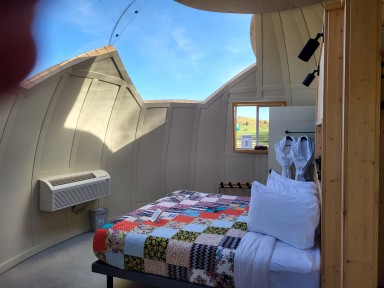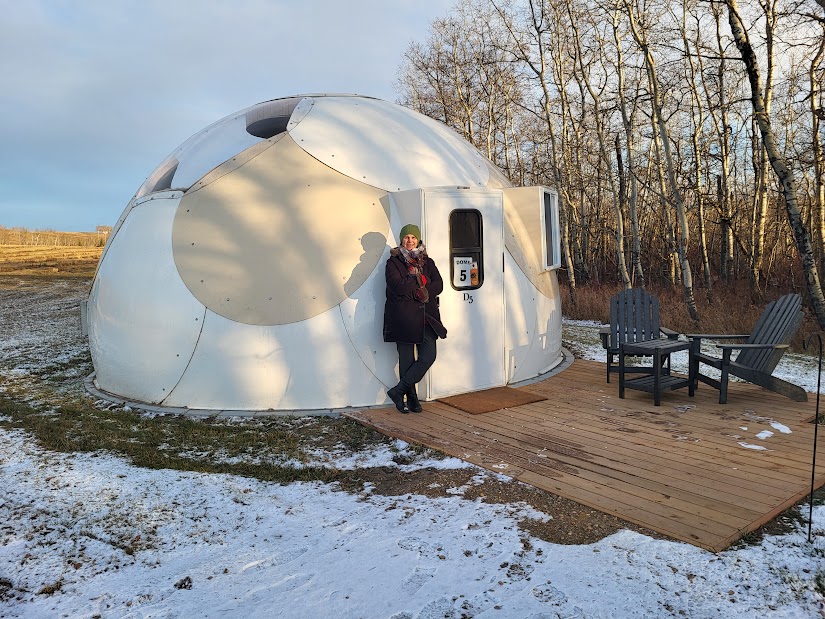Eyes on the Sky
Watching the stars was the goal for a night in a sky watching dome at Métis Crossing.
Inside the dome, one of eight, I laid on the king-sized bed and gazed through two huge ceiling windows as falling stars zipped by above. The aurora borealis (Northern Lights) did not show up, but there was peace in the setting beside the North Saskatchewan River. The underfloor was heated, cushy bathrobes hung at the ready and the kitchenette included a coffee machine.
Indigenous Tourism Alberta supports experiences such as this, the province’s first major Métis cultural and interpretive centre. The impressive gathering place at Métis Crossing includes a hall with a vaulted ceiling, fireplace, meeting rooms, gift shop (including books), restaurant, bistro café, 50 hotel rooms, and on-site camping in the summer.
The day I arrived to stay in a sky watching dome was November 8, Indigenous Veterans Day. Bruce Gordon, a Métis veteran, shared that more than 12,000 Indigenous people joined up in the first and second world wars and Korean War, even though “status Indians” only received the right to vote in 1960.
Juanita Marois, CEO of Métis Crossing, explains that our purpose for travel has changed. Once we travelled to see the world, she says. This shifted to adventure travel. Now, we want to expand our knowledge of other cultures.
“People want to feel they are contributing something to the world these days,” says Marois. “They want to dive deep into learning about other cultures. Indigenous tourism is the fastest growing form of tourism in the world.”
On the Métis Crossing website, a list of upcoming events is enticing. There are ongoing activities including traditional art workshops, hands-on experiences like Tales from the Trapline, and cross-country skiing.
The facility is impressive, reflecting that the Métis of Alberta have worked hard for recognition and respect. In 1938, 12 self-governed Métis “colonies” (now known as settlements) were formed. Eight of these survived the struggle to establish a land base in remote areas of Alberta. Even today, the struggle continues. Forty per cent of East Prairie Métis Settlement burned during this summer’s fires.

The night skies are not the only reward for the 90-minute drive to Métis Crossing, north and east of Edmonton. Nature abounds on the 512-acre site of forest, fast-flowing river, open fields, and gentle hills.
Book ahead for a guided tour of the Visions, Hopes, and Dreams Wildlife Park. The Métis connection to the land is felt as you are transported to view a rare white bison, wood bison, plains bison, elk, and even Percheron horses.
My big reward was seeing a determined porcupine cross the field outside the sky watching dome. I celebrated my first sighting of a porcupine!
The next day included a short drive to the Victoria Settlement, part of the Victoria District National Historic Site of Canada.
Corporal Vernon Hagen, an RCMP participant in the Indigenous Veterans Day event, had shared the significant history of the Victoria Settlement. One connection, he noted, was a friendship between Cree Chief Pakan of Whitefish Lake, a Methodist believer, and George McDougall, the Methodist minister who arrived in 1862.
The site’s Indigenous roots go back 10,000 years. By 1864, the Hudson’s Bay Company established Fort Victoria here. The white-washed clerk’s quarters is one of Alberta’s oldest buildings. A short walk away is the Pakan Ferry Crossing, operated from the late 1800s to 1972. The site is open to tours from the May long weekend to Labour Day.
The website for Indigenous Tourism Alberta includes many Alberta places with First Nations, Métis, and Inuit activities. Start planning your year-round visits now. You will not be disappointed.
Métis Crossing is located at 17339 Victoria Trail, Smoky Lake.







